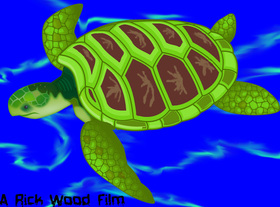 One of the animation "cells." I just finished up 43 seconds of "final cut" animation for the film. It's a piece I'd been working on for nearly eight months now.
There will be another animated sequence in the film, too. That one is almost ready to be rendered.
The thing about these scenes is that they happened when no one was around to see it - out in the open ocean or under the sand. I chose to animate them because they are both important to the overall story and hard to imagine with just a narrative description.
I hope, too, that younger viewers will gain a better understanding of the whole story from the animated scenes.
Most of all, I'm happy with them...and that is actually saying A LOT.
The film continues to be tweaked and edited. The final storyboards were finished and laid out last weekend.
I can only say that I love this version of the film MORE than I did the first one..and the first version was fantastic.
Cheers,
-Rick
Hi fans!
I thought I would throw up a quick blog to let everyone know...well, not much, really.
The reason you haven't heard much out of me for the past couple of weeks is simply due to the fact that I have nothing "new and exciting" to tell you.
I'm still working on the post production for the doc and, at this moment, I'm in a slight holding pattern while waiting for music. After the music tracks are delivered, then I'll start putting the "rough cut" together. Once the rough cut is finished, I will screen the film with Loggerhead's staff and get final approval to officially release Journey Home.
The release date is still on track for the End of March or very early April.
So, right now, if you don't hear anything out of me, just remember, "no news is good news."
Cheers,
-Rick
As I've worked on Journey Home - and, as I work on other productions - I'm being confronted more and more with questions about "how" someone goes about making an independent film for less than $10K. The short answer is that you don't need more than an HD camera and a solid idea to make a film. The slightly longer version of that answer is that, if you want distribution...revenue...awards at film fests, well, then you'll need more than basic talent and a camera.In some ways I feel I was lucky to not know some of the "facts" that I know now. The daunting nature of the various legalities, associated costs, logistical imperatives and certain necessary steps might have made me over think my plan to film my doc from scratch, by myself and raise the funding as I went. I simply took my idea of wanting to film sea turtle rehab, got permission to film and started right-in on doing it. It never occurred to me that I had much to be concerned with. Some lessons I would learn as i went along. During the original filming phase and post production of Journey Home (euphemistically called, "Journey Home 1.0"), I got it in my mind to score part of the film to a song I loved by recording artist Loreena McKinnett. So, having never done this sort of thing before, I took it upon myself to look up contact info for her recording label, write a detailed proposal for the usage and then ask if they could "donate" its use to the film. Sounds crazy, right?Well, it actually worked. The song "Dante's Prayer" was given special permission and licensing approval for (at least) the first wave of DVDs to be used by Loggerhead Marinelife Center. In all, it took five months of work, wonderful and considerate assistance from Quinlan Road records and a a bit of luck (though, some would say "sweet talking") to get it into the film. Sadly, the necessitated re-shooting of the entire documentary made it impossible to simply "re-do" the agreement. The song was dropped from the sequence (heck, even the sequence was dropped) and the new version of the film will have only original scoring by Mike White. The next thing I came across was the fact that I wanted underwater footage of the turtles that was shot directly and not from the porthole in their rehab tanks. For that and a few other pieces of gear (all stuff that I had no preconceived notion I would need), I would need to raise money. So, I Googled, "Raising funds for film." Lo and behold, there were websites to do just that. I settled on Kickstarter because I liked their business model and I felt like it would reach the maximum audience for "pledgers."Kickstarter is a HUGE resource for independent and low-budget artists. Last year alone, projects on the crowd-funding website raised more than $319 Million. I will reiterate that for effect: $319 Million from people pledging mostly $10 here...$100 there...heck, Journey Home (1.0 and 2.0) raised slightly more than $4 K using Kickstarter. By the way, and this may surprise many of my fans (some of whom pledged on BOTH Kickstarter campaigns), the largest, single pledges came from absolute strangers who stumbled upon the project. I can honestly say that without it, there would be no film.When it came to legality, I again learned as I went along. There are a lot of resources online these days and I think I may have tapped into all of them when it comes to filming permissions, releases and distribution rights. My standard release form is simple and was modeled after a template provided for free on the On MY Block Films website.Now, keep in mind I have worked on this doc for 15-months and none of these "lessons" happened overnight. I also sought out and read (so far) eight books on independent filmmaking and directing. When it comes to something you're passionate about, there is no such thing as "too much knowledge."To that end, I am also currently enrolled in film classes at Indian River State College in their "film track" program.AT some point, after I have the new, finished, 2.0 version of the film completed, I promise I will create a more in-depth "how-to" guide on this website. Because I want to inspire and encourage others to make films, tell unique and important stories and help change the world, I'm committed to sharing what I know. Making a film is NOT an easy task. But, if it's done well, it impacts people to their cores.With great filmmaking comes great responsibility...or something like that.Cheers,-Rick
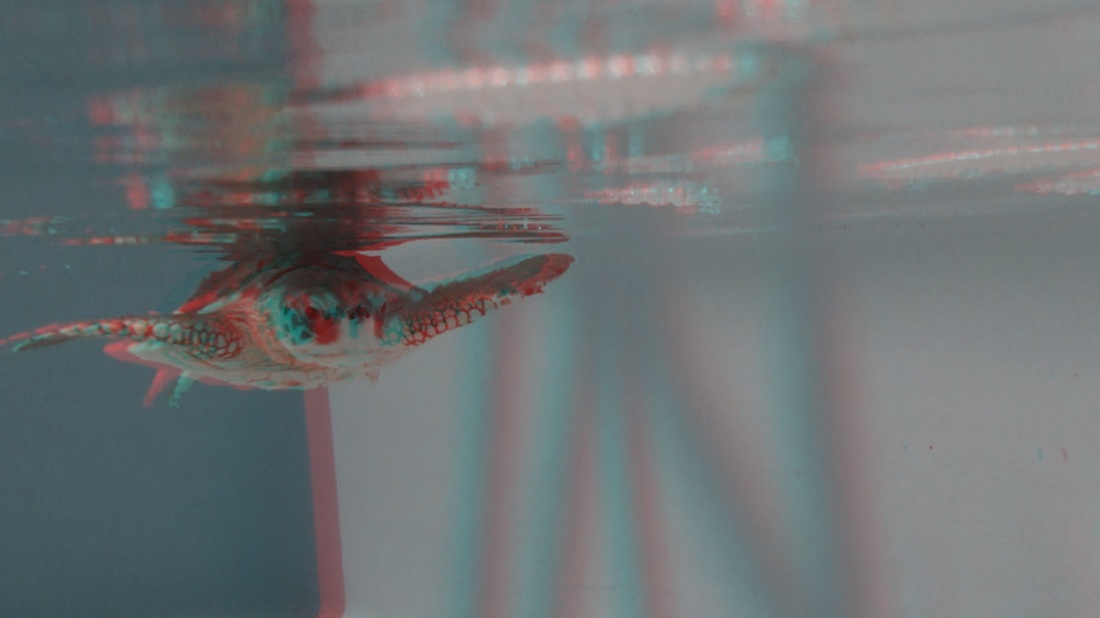
Working on a few "extras" for the DVD. There will be a short video in red/blue 3-D. Here's a still of Chestnut, a young Kemps Ridley that was rehabilitated at the center last year.
"It's easy to see a problem and feel helpless to anything about it. When you look at environmental and animal conservation issues, it's easy to get caught in the avalanche of dire predictions. I always go back to the Starfish fable when I lose faith in my purpose. Saving one animal - changing one mind - makes ALL the difference for that individual. Small victories will add up."
Journey Home is in that quasi-limbo land of post production. I wish I had cool things to post about it, but, honestly, it's really all writing, planning and storyboards at the moment. Watching paint dry would be far more entertaining...really.
As we enter 2013, I am struck by the fact that I will have worked on the film for parts of 2011, 2012 and, now, 2013. The doc is truly a journey in itself.
Looking back on 2012, I can say with some assurance that it was a very memorable year for the film. Highs....lows...success and failure. I wouldn't trade a second of it all for the experiences I've gained.
So what does 2013 look like? Is there a timeline in place for what happens when? Yes....and no.
I want to have the film completed in time for Loggerhead's "Turtle fest" in April. I also "want' a million dollars and the ability to play the banjo. What will determine the timeline for the film is how long it takes me to craft the best story possible. Period. Still, my personal deadline is April 1st. That might work out on many levels.
However, during this period of post production, support becomes critical. I will continue to bounce concepts and footage off of my "fans" throughout this time. I'll be looking to you folks to tell me what works and what doesn't.
So, here's to hoping 2013 is a an amazing and wonderful new year for all of us.
Peace, love and cheers,
-Rick
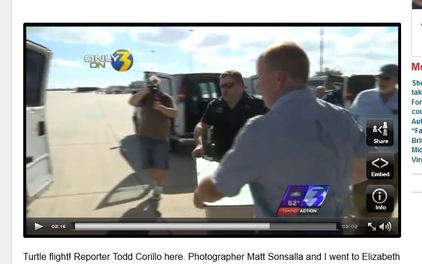 When I'm working on the film - even when I'm not actually "working" on it, too - I can get tunnel vision and not see the world around me. I get lost in the story as it unfolds.
Filming the cold-stunned sea turtle rescue operation was like that. Once I was rolling, there really was nothing but the drama of 35 turtles being transported more than a thousand miles in an effort to save their lives.
Saving lives, whether it is in regards to turtles or people, is dramatic by its very nature. Even after the turtles made it safely to Florida from Massachusetts, they faced uncertainty and a long recovery.
What they need now is caring and compassion - and they are getting it in spades at Loggerhead MC.
I post about this now because it also relates to how we, as journalists, can be when it comes to a tragedy like the recent mass shootings in Connecticut. When you cover an event like that you might have tunnel vision at first - just focusing on the "story." But there are lives involved....emotions and pain. No matter how "dramatic something is, if we fail to see the humanity of the situation, we also fail to exercise humanity in our coverage.
My heart goes out to all of those affected by the recent tragedy. My heart also goes out to all of those left with "tunnel vision."
Sometimes, it's OK to put down the camera....and simply weep.
-RW
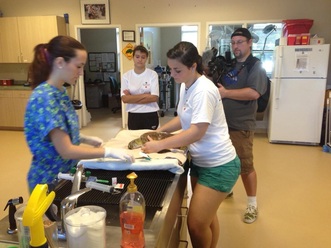 Image credit: Dan Bodenstein The last scenes of primary footage were filmed today. In a 4.5-hour-long filming marathon, I was able to get footage of research, conservation efforts, educational programs and a few, last bits of medical care for a shark bit victim (turtle).
What this means is that the re-shoot for Journey Home, which started in September, now moves into post-production or the editing phase.
Journey Home 2.0 is a very amazing story...and one that is phenomenally different from the first, completed film.
I feel that I "lucked out" again in having the opportunity, not just to do it over, but to craft a stronger, more "timeless" documentary.
The newer story encompasses the global problem of saving a species as seen through the efforts of Loggerhead Marinelife Center.
I can say with 100-percent certainty that this would not be possible without the help and support of many, many people.
I wasn't a one-man band in doing this film. I'm still not.
I'm grateful for that.
As I have said once before, "now begins the hard part."
I finally got around to rendering a new trailer for the documentary re-shoot. There are just a couple of fine tuning items I'll need to finish before it's ready to go live. Having said that, I'm pretty sure it'll be done tomorrow!
One can only hope, anyway.
In the meantime enjoy these stills from the production.
Cheers,
-Rick
"The world is a finite space. Every grain of sand displaced by one thing will impact another. With that in mind, we have an obligation to tread very, very lightly." - Rick Wood
When I started filming "Journey Home" in October of 2011, I knew I'd see drama unfold during the course of saving the lives of sea turtles. I knew, too, there would be loss and sorrow. For more than a year, I've seen triumph and tragedy play out too many times to count. As a filmmaker I think about how "lucky" I have been to capture these dramatic - yet not overly emotional - scenes. Time and time again the most poignant scenes are the ones that illustrate just how directly - and, in some cases, adversely - humans impact the life cycle of these endangered species.Sometimes it's the unintentional by-product of an industry, like commercial fishing or boat operation, but far too often it comes from ignorance and carelessness. I have watched turtles die because of it. "Journey Home" will carry the message of sea turtle awareness and education. In subtle scenes, viewers will see the results of litter, negligence and apathy on creatures who - if left unmolested - might have numbers so healthy as to no longer carry the "endangered species" identifier. There is only one chance at this and it is right now. If we fail in preserving and protecting sea turtles, they will vanish into extinction.My philosophy while filming is simple: tell their story. It's not to "create" a story or "embellish" a story...it is simply to show others what I have been privileged to see.Of course, as a visual artist, I hope to do it in a way that will be interesting and will have an impact on anyone who sees it.What's more, you don't have to wait for the film to finish production. All of the information and tools to educate folks about the issues facing sea turtles are here - on the film's site. If you have other questions or want more information, visit Loggerhead Marinelife Center's website: http://marinelife.org/
|





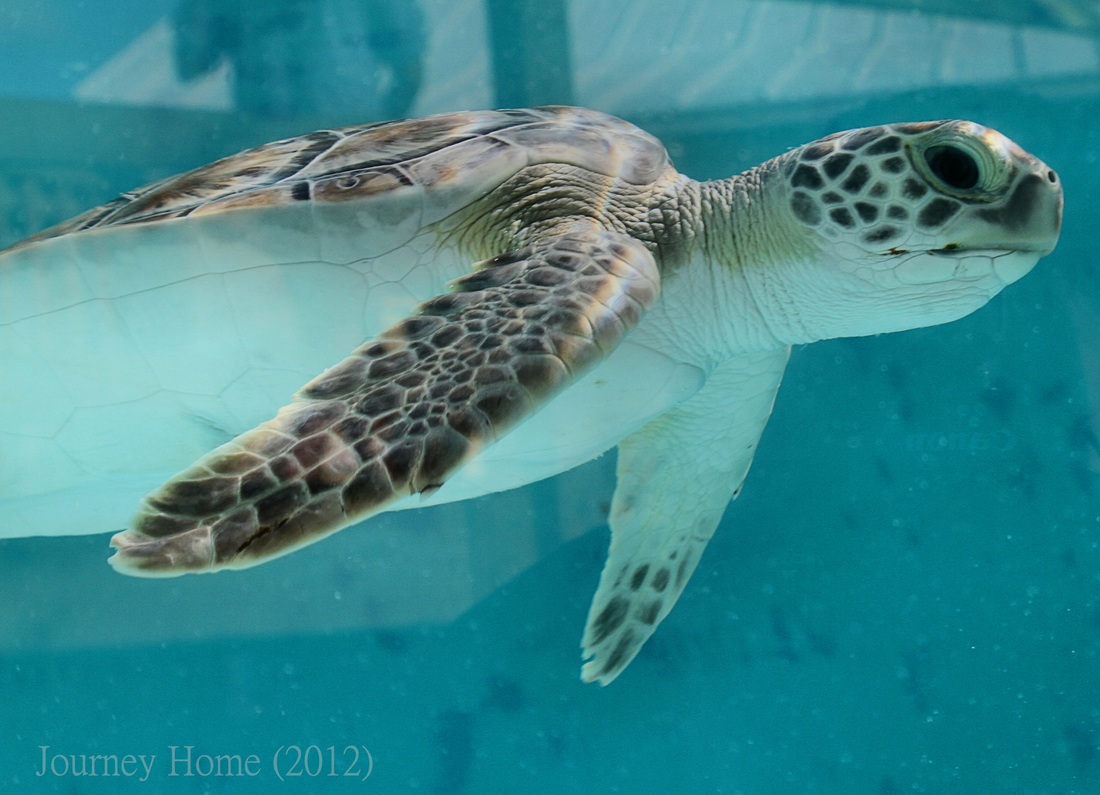
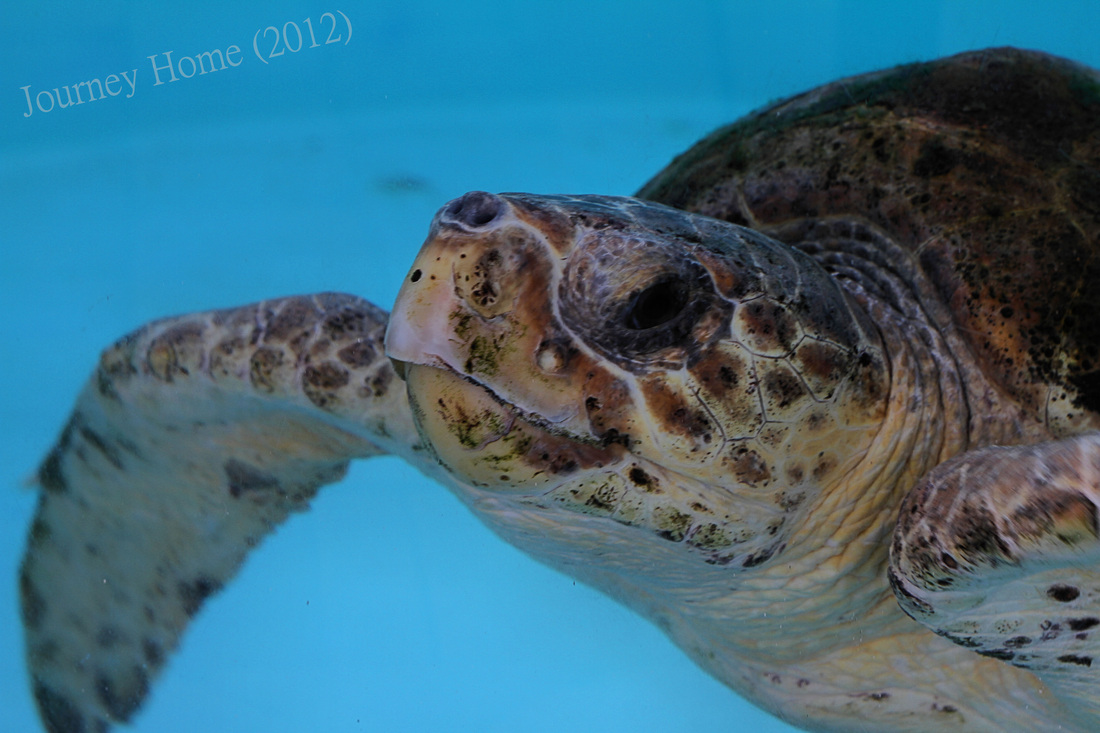
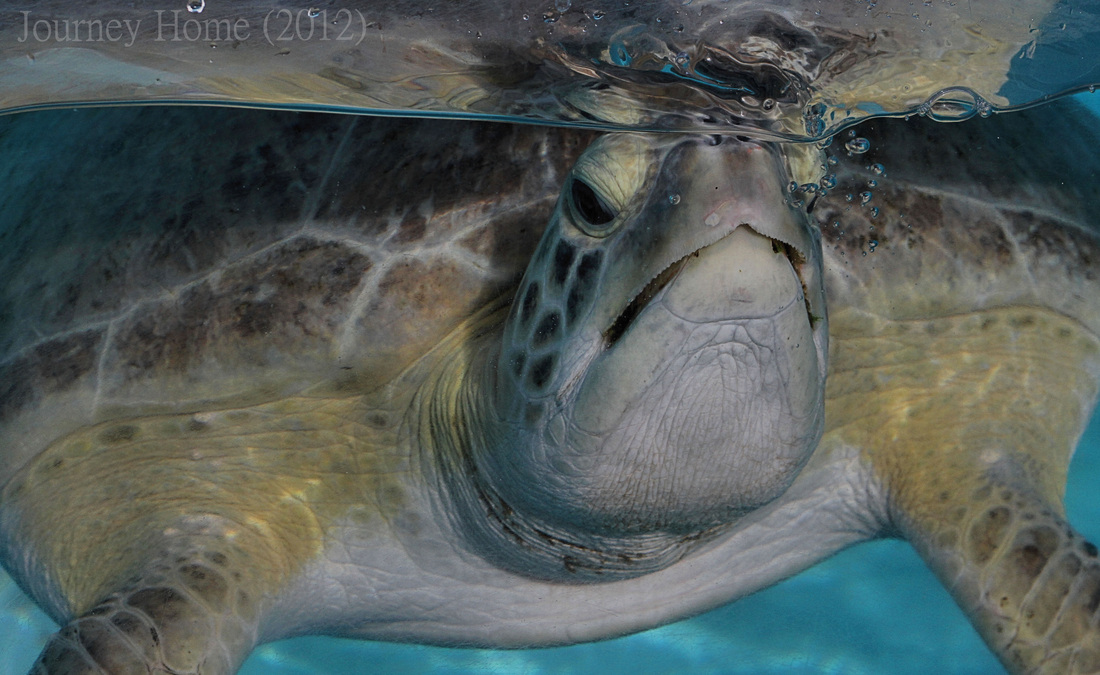
 RSS Feed
RSS Feed